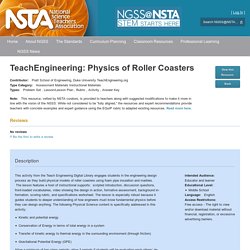

TeachEngineering: Physics of Roller Coasters. MS-ETS1-4 Develop a model to generate data for iterative testing and modification of a proposed object, tool, or process such that an optimal design can be achieved.

Clarification Statement: none Assessment Boundary: none This resource is explicitly designed to build towards this performance expectation. Comments about Including the Performance Expectation This activity presents a good opportunity to help learners understand that there are different kinds of models.
In this lesson, they will be developing a physical model. MS-PS3-5 Construct, use, and present arguments to support the claim that when the kinetic energy of an object changes, energy is transferred to or from the object. Clarification Statement: Examples of empirical evidence used in arguments could include an inventory or other representation of the energy before and after the transfer in the form of temperature changes or motion of object.
Assessment Boundary: Assessment does not include calculations of energy. Google Docs - create and edit documents online, for free. Cosmic Collisions. Cosmic Collisions Activity: Impact Cratering by Ronald Greeley, Arizona State University (Adapted from the NASA workbook, Activities in Planetary Geology) Materials A tray or very strong box at least 2 feet on a side and about 4 inches deep A large supply of extremely fine sand Four identical marbles or small ball bearings Three solid spheres about 1 inch in diameter, all the same size but made of different materials, for example, glass, plastic, steel; or glass, wood, aluminum) Meter stick 10-centimeter ruler Toy Slingshot (Optional) Kitchen tea strainer Dark color of dry tempra paint (powder); for example, red or blue Safety glasses or goggles Large pack of assorted marbles One steel ball bearing about 1/2'' in diameter Procedure Pour sand into the tray to a depth of at least 3 inches.

Importance of Mass of the Impacting Object on Craters From a height of 2 meters (6 feet), drop each of the large spheres (three different types) into one area. The Structure of a Crater Cratering on the Moon. How%20Heavy%20How%20Far.pdf. Brilliantly. Joseph Herscher - Kinetic Artist. OK Go - This Too Shall Pass - Rube Goldberg Machine version - Official. Free K - 12 Common Core Lesson Plans and Ideas. Free K - 12 Common Core Lesson Plans and Ideas. Free K - 12 Common Core Lesson Plans and Ideas. Free K - 12 Common Core Lesson Plans and Ideas.
Free K - 12 Common Core Lesson Plans and Ideas. Coaster%20Construction-AIMS.pdf. Build a Bobsled Racer. Activity adapted from the Museum of Science, Boston‘s Design Challenges, a program of hands-on activities developed to help students and visitors explore the engineering design process, and from the version modified for classroom use by California’s Tech Museum of Innovation.

Click on link to view the educator’s guide (.pdf) Summary Teams of students in grades 3 to 8 learn about friction, forces, and the engineering design process by building and testing miniature bobsleds to see which can race down an icy slope either the fastest or slowest. Grade level: 3-8 Time: 20 minutes for the activity, 10 minutes for setup and clean up. Learning outcomes After doing this activity, students should be able to: Standards International Technology and Engineering Educators Association Energy is the capacity to do work. Next Generation Science Standards The Challenge Design a bobsled to race down the icy slopes as quickly or as slowly as possible.
Materials Procedure Before the activity Activity 1. 2.Create. 3. 4. May%20The%20Force%20Be%20With%20You.pdf. Rube Goldberg Project. Cross Discipline Science Lesson, HS Next Generation Science Standards. Rube Goldberg Machine Project - Google Docs. Dissecting a Spring powered Motor for a Pull Back Toy Spring2014 v1. 6th - Physical Science - Energy. Grade 6 Physical Science Energy in Earth Systems Written By: Kim Castagna Jennifer Foster Meagan Callahan Tracy Schifferns Developed in Conjunction with K-12 Alliance/WestEd All 6th Grade Physical Science Energy in Earth Systems – Lessons and Literature can be Downloaded hereDownload Complete Grade 6 Physical Science Energy in Earth Systems Download Physical Science: Energy in Earth Systems Introduction and Conceptual Flow Narrative PDF Grade 6 Physical Science: Energy Introduction and Conceptual Flow Narrative Introduction: This Grade 6 Physical Science Unit focuses on energy in earth systems and addresses the California Science Standards for 6th grade for the topic of energy in Earth systems and Investigation and Experimentation Standards.

Concepts about Energy in Earth Systems are used throughout the following grade six Earth Science Units: Plate Tectonics, Earthquakes and Volcanoes, and Weathering and Erosion. Energy that is transferred or transformed starts with a source.